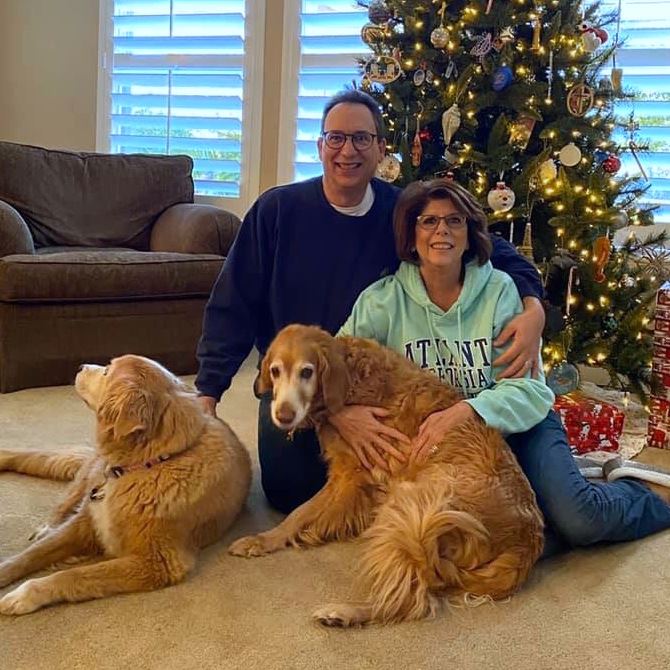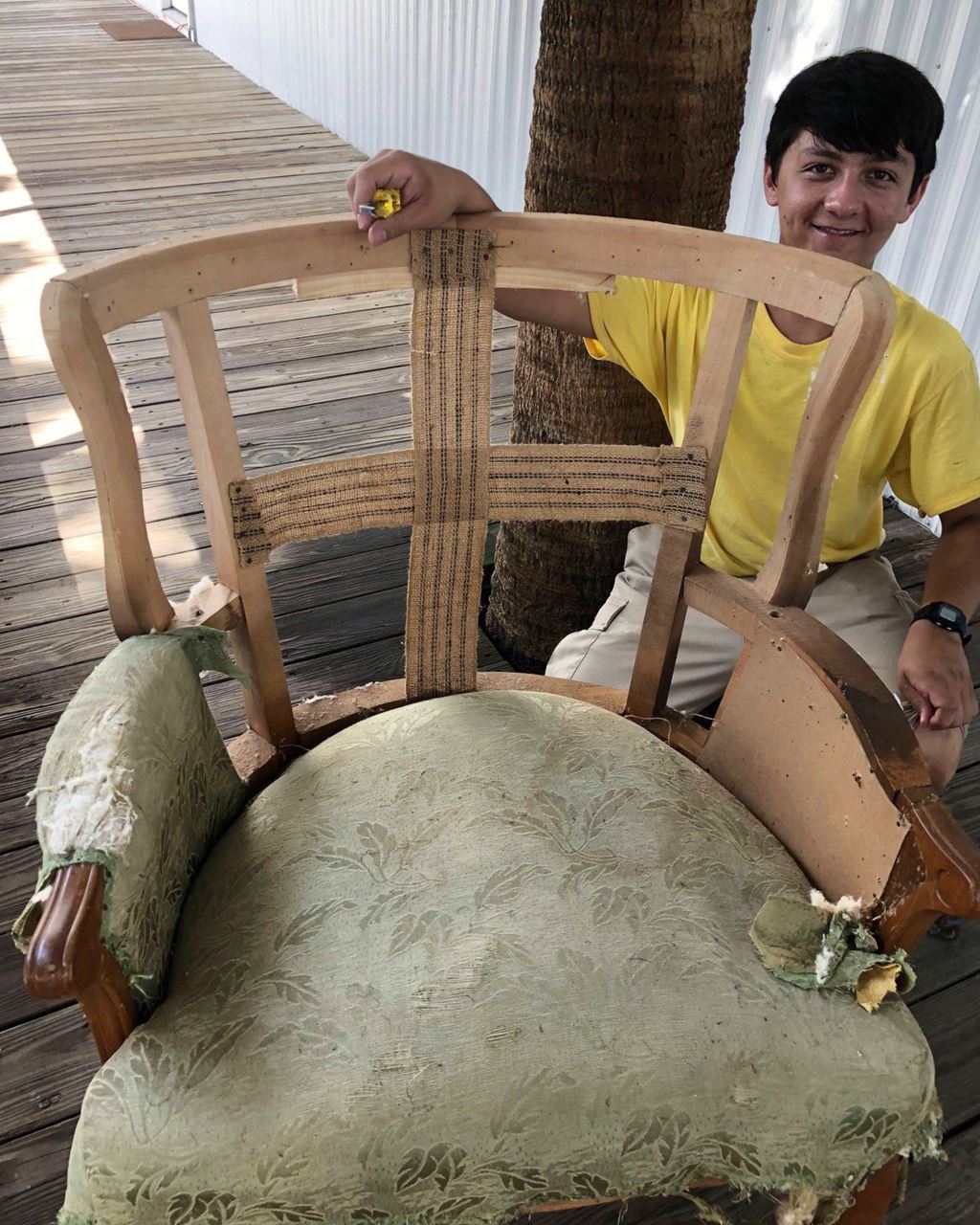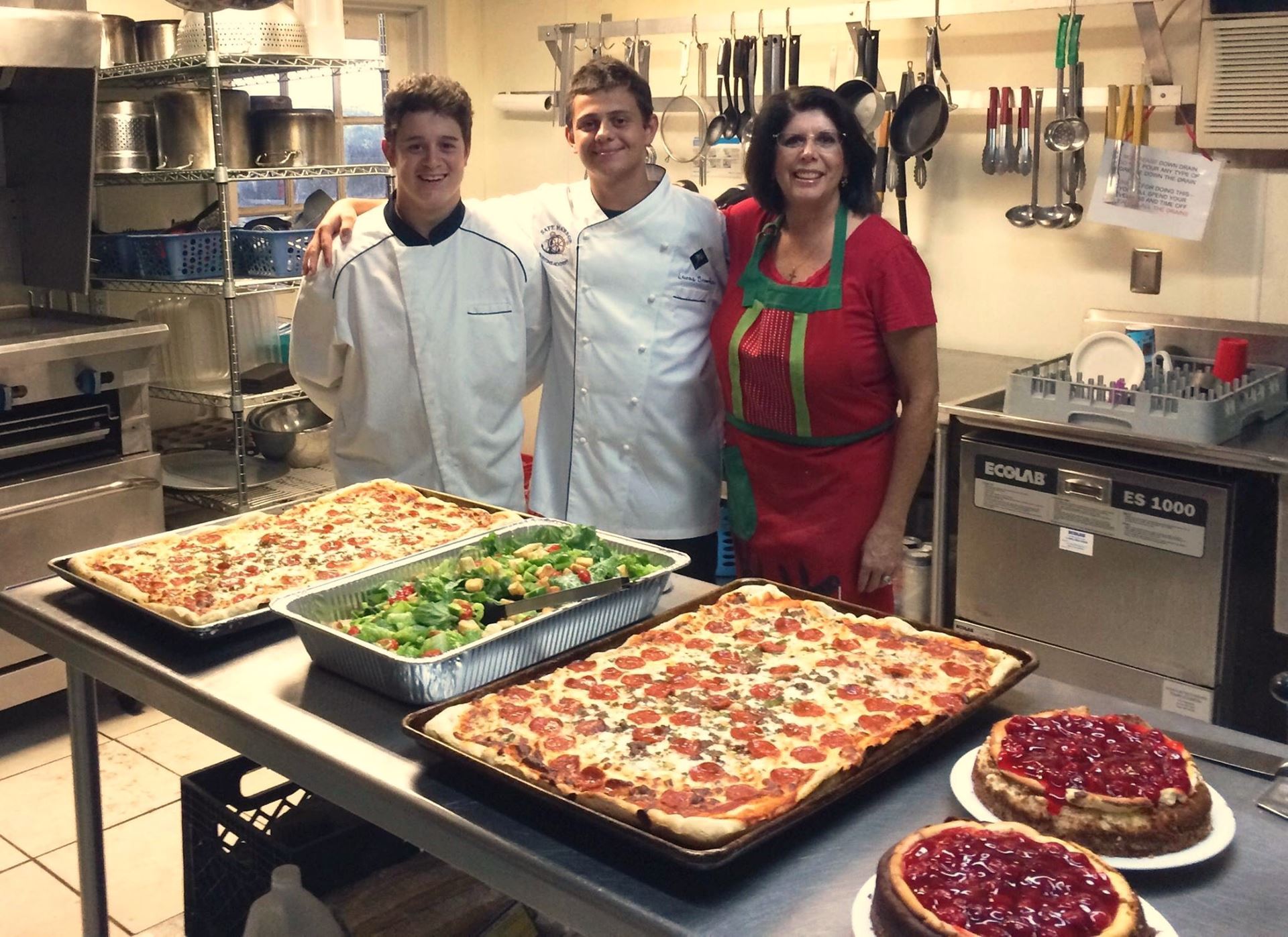written by Nancy Sargent, NUA volunteer and owner of Cobani Bleu The Art of Sitting Soft
________________________________________________________
This month we spotlight NUA members John and JoAnn Greco of J&J Custom Designs and their unique upholstery program for at-risk youth.
Designing An Upholstery Program For At-Risk Youth
Three years ago, John and JoAnn Greco delivered a birthday cake to Safe Harbor Academy, on behalf of her women’s circle at church. They had no idea how this delivery would impact their lives, but the first clue was being met at the door by a golden doodle. Their love runs deep for their two golden retrievers, Bella and Zoe but not so much for the volume of shedding that comes with owning two goldens. They have often said, maybe the next dog will be a doodle. Now being greeted by a golden doodle seemed to be a sign for sure.

The Grecos live a good life in Jacksonville, FL. Wanting a way to give back for their blessed life, they had been searching for just the right opportunity to help others. A must for this venture was something they could do together.
In addition to meeting a golden doodle, John and JoAnn also met Robbie and Doug Smith, ordained pastors, who run Safe Harbor Academy. Thirty-six years ago, Robbie and Doug were also living a good life. In fact, Doug had just sold a successful business and he and Robbie were about to embark on a round the world voyage in their yacht. Before they could set sail, a friend who was a judge, stepped in and asked them to take a couple of boys for the weekend, so these boys wouldn’t have to go to a juvenile detention facility.
This was this start of a new life for Robbie and Doug. It was also the start of Safe Harbor Academy, a non-profit, maritime-based boarding school for at-risk boys aged 14-17. Utilizing maritime principles as well as a disciplined structure, the boys live on donated boats within the Safe Harbor marina. In addition to continuing their high school education, (the Academy is an accredited school), the boys are responsible for much of the maintenance of their own boat. They not only learn seamanship and maritime skills, but also welding, mechanics and wood working skills. They cook their own meals and are responsible for the upkeep of the marina property. The boats are all donated and can be in pretty rough shape. As they fix up the boat they live in, they learn many skills.
Here is where John and JoAnn enter the story. Upon meeting Robbie and Doug, touring the facility and hearing the history of Safe Harbor, they knew they had found something special. A place they could make a difference. On the tour John and JoAnn were shown a dilapidated trailer that had once housed the marine upholstery shop. Their first task was to rehabilitate the trailer and get the upholstery program going again. As with most of the assets of Safe Harbor, all the equipment was donated and may not have been in the best shape. Having sat idle in the salty Florida air, the machines were rusty, crusty and old. John and JoAnn took a leap of faith and plunged into this project. They knew it is the right place to put their talent and efforts even though they had limited upholstery experience.

JoAnn is an experienced and passionate sewer. Her accounting background lends itself well to details. John, with a career in the IT industry is more visionary. At one time John and JoAnn were certified foster parents. Although foster parenting never worked out for them, the intense training they went through for the certification has played very well with their current work at Safe Harbor. Together they make a great team. Upholstery was very much a skill and trade they wanted to undertake. JoAnn, with the help of a friend, had upholstered a chair and was bitten by the upholstery bug. When they walked into Safe Harbor that day 3 years ago, everything just fell into place.
They found Kim’s Upholstery and began following her online classes. They supplemented online education with as many hands-on classes as possible including those from Kim and Cynthia Bleskachek of The Funky Little Chair. They network with both upholstery and marine industry partners. This past summer they built a workroom addition to their home and have invested in the right tools. As they grow the upholstery program at Safe Harbor, they are also building their own business, J&J Custom Designs specializing in both residential and marine upholstery.
When JoAnn began to formulate a program, she knew to start at the most basic step. Every student starts with learning to thread a needle and sew a button. When boys come into the upholstery program, they are given the privilege of first working on projects for their own boat, projects in which they take immense pride. As is a common occurrence in upholstery, every project is different and nothing is more true than the upholstery program at Safe Harbor. Attendance in upholstery class fluctuates for many reasons, often without notice. John and JoAnn see this as an opportunity to work with the boys on a one-to-one basis, putting that foster parent training to good use. Knowing how to listen goes a long way in developing trust, something that these boys are not accustomed to. So much so that John and JoAnn are considered an integral part of the Safe Harbor staff.
An early first need was to see if any of the sewing machines could be resuscitated. Through a fabric store in Fernandina Beach, JoAnn connected with a retired gentleman named Tony Baker. His wife, a quilter, loves Singer Featherweight sewing machines. So Tony mastered how to keep them running. With these skills he was able to get a few of the Safe Harbor machines working. Now mind you, some of these donated machines pre-dated World War I, verified by the fact that they had no reverse. This collection of machines includes several Singers and TacSews, one just for making sails, a Thompson mini walking foot. All have clutch motors and are noisy beasts. They have also pretty much lived beyond their life expectancy, maybe even several times over. Safe Harbor is very much in need of a new machine or maybe one that is not pushing the century mark. One plan for a new sewing machine is to auction off a pair of newly upholstered chairs done in the theme of the Jacksonville Jaguars Football team. It’s hopeful that money generated from the sale of these two chairs could get that new sewing machine.

In addition to working on their own boats, the boys work on many other projects throughout Safe Harbor. One particular area of pride is the Grand Salon located in a donated 121’ power yacht. This yacht is often used for fundraising efforts and the boys’ work takes center stage offering the public a view to the boys’ skills and workmanship. Another recent project was recovering all the seats in their classroom with marine vinyl donated by Fabric Supply Inc. in Minneapolis, MN, an NUA Industry Partner. (Thank you FSI for your generous donation!) The Greco’s industry connections and resourcefulness is key for meeting the needs of the program. In addition to Fabric Supply Inc., Stratta Glass and O’Sea have both donated glass, the plastic fabric that is used for windows in marine applications. The Grecos have also contributed hand tools for which there is a continual need, as the salty air corrodes the metal after just a few years. There is no budget for foam or Dacron or any supplies really. Cushion inserts are reused after cleaning and a good drying in the hot Florida sun. Besides a sewing machine, good lighting is a high priority. Having no budget for supplies forces the students to be resourceful with what they have, and in the end they are very proud of their work.

Many of the boys in the Safe Harbor program are diagnosed with ADHD. They are not allowed any drugs for managing their condition. Instead the boys are kept busy with classwork, and learning how to live a marine based life. There is no screen time at Safe Harbor. For fun they race sailboats. They study hard and work hard. Life at Safe Harbor is strict and disciplined, but also full of fresh air, time at sea and a nurturing environment. The boys are encouraged to follow their passions. One young man wants to be a chef, so he was able to take on an apprenticeship at a local restaurant. For another young man, upon leaving Safe Harbor told Miss JoAnn, ‘When I get home, I’m going to get my grandma’s sewing machine out and keep doing this.‘ There is interest by several students to pursue upholstery as a career. Having the opportunity to positively impact the lives of these young men and maybe fostering the next generation of upholsterers is the reason why John and Joann are so passionate and dedicated to this program.
What’s next for the program? John and JoAnn would love to work towards creating a certificate program possibly in conjunction with the Marine Fabricators Association. A program that could establish some standards, so that when the program is completed, a student has not only a certificate of his accomplishments but also a certification of his upholstery skills that may be useful in obtaining work or an apprenticeship upon leaving Safe Harbor.
Safe Harbor has a 90% success rate, meaning that upon completing the program, a young man leaves with his high school diploma and a plan. A plan for the next phase of his life, which might include joining the military or getting a job. Graduation is a time to celebrate, and John and JoAnn celebrate every one of these young men, even those that don’t come into the upholstery program, because they are all family. You know the family that sometimes makes you want to ring their neck, but you probably just hug them instead.

If you are interested in learning more about Safe Harbor, their website has a good history of the program. You could watch the Safe Harbor movie produced by Hallmark, released in 2009, starring Treat Williams and Nancy Travis, which tells the story of Safe Harbor’s early days. (It’s streaming on Amazon Prime.) Or contact John and JoAnn, they’d love to tell you all about their program.